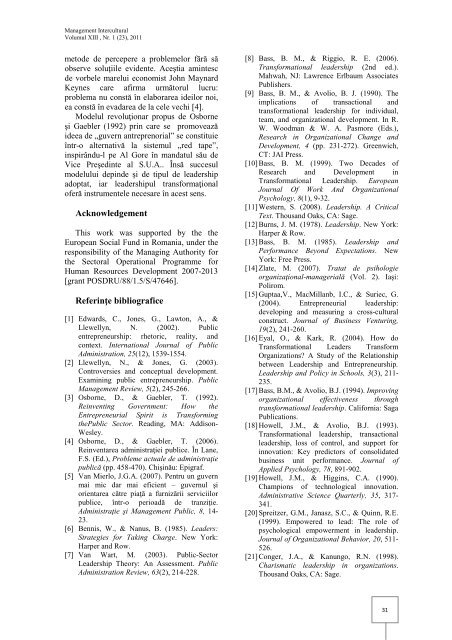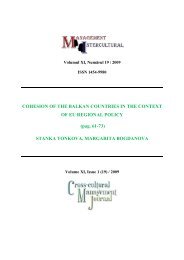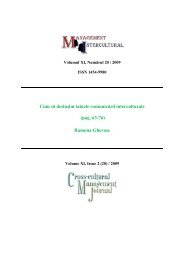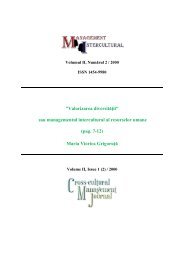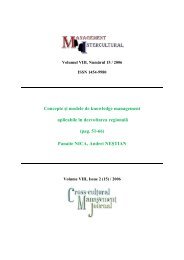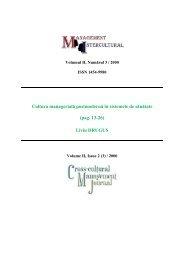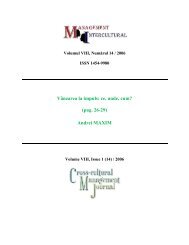Andreea BAHNAREANU - Management Intercultural
Andreea BAHNAREANU - Management Intercultural
Andreea BAHNAREANU - Management Intercultural
You also want an ePaper? Increase the reach of your titles
YUMPU automatically turns print PDFs into web optimized ePapers that Google loves.
<strong>Management</strong> <strong>Intercultural</strong><br />
Volumul XIII , Nr. 1 (23), 2011<br />
metode de percepere a problemelor fără să<br />
observe soluţiile evidente. Aceştia amintesc<br />
de vorbele marelui economist John Maynard<br />
Keynes care afirma următorul lucru:<br />
problema nu constă în elaborarea ideilor noi,<br />
ea constă în evadarea de la cele vechi [4].<br />
Modelul revoluţionar propus de Osborne<br />
şi Gaebler (1992) prin care se promovează<br />
ideea de „guvern antreprenorial” se constituie<br />
într-o alternativă la sistemul „red tape”,<br />
inspirându-l pe Al Gore în mandatul său de<br />
Vice Preşedinte al S.U.A.. Însă succesul<br />
modelului depinde şi de tipul de leadership<br />
adoptat, iar leadershipul transformaţional<br />
oferă instrumentele necesare în acest sens.<br />
Acknowledgement<br />
This work was supported by the the<br />
European Social Fund in Romania, under the<br />
responsibility of the Managing Authority for<br />
the Sectoral Operational Programme for<br />
Human Resources Development 2007-2013<br />
[grant POSDRU/88/1.5/S/47646].<br />
Referinţe bibliografice<br />
[1] Edwards, C., Jones, G., Lawton, A., &<br />
Llewellyn, N. (2002). Public<br />
entrepreneurship: rhetoric, reality, and<br />
context. International Journal of Public<br />
Administration, 25(12), 1539-1554.<br />
[2] Llewellyn, N., & Jones, G. (2003).<br />
Controversies and conceptual development.<br />
Examining public entrepreneurship. Public<br />
<strong>Management</strong> Review, 5(2), 245-266.<br />
[3] Osborne, D., & Gaebler, T. (1992).<br />
Reinventing Government: How the<br />
Entrepreneurial Spirit is Transforming<br />
thePublic Sector. Reading, MA: Addison-<br />
Wesley.<br />
[4] Osborne, D., & Gaebler, T. (2006).<br />
Reinventarea administraţiei publice. În Lane,<br />
F.S. (Ed.), Probleme actuale de administraţie<br />
publică (pp. 458-470). Chişinău: Epigraf.<br />
[5] Van Mierlo, J.G.A. (2007). Pentru un guvern<br />
mai mic dar mai eficient – guvernul şi<br />
orientarea către piaţă a furnizării serviciilor<br />
publice, într-o perioadă de tranziţie.<br />
Administraţie şi <strong>Management</strong> Public, 8, 14-<br />
23.<br />
[6] Bennis, W., & Nanus, B. (1985). Leaders:<br />
Strategies for Taking Charge. New York:<br />
Harper and Row.<br />
[7] Van Wart, M. (2003). Public-Sector<br />
Leadership Theory: An Assessment. Public<br />
Administration Review, 63(2), 214-228.<br />
[8] Bass, B. M., & Riggio, R. E. (2006).<br />
Transformational leadership (2nd ed.).<br />
Mahwah, NJ: Lawrence Erlbaum Associates<br />
Publishers.<br />
[9] Bass, B. M., & Avolio, B. J. (1990). The<br />
implications of transactional and<br />
transformational leadership for individual,<br />
team, and organizational development. In R.<br />
W. Woodman & W. A. Pasmore (Eds.),<br />
Research in Organizational Change and<br />
Development, 4 (pp. 231-272). Greenwich,<br />
CT: JAI Press.<br />
[10] Bass, B. M. (1999). Two Decades of<br />
Research and Development in<br />
Transformational Leadership. European<br />
Journal Of Work And Organizational<br />
Psychology, 8(1), 9-32.<br />
[11] Western, S. (2008). Leadership. A Critical<br />
Text. Thousand Oaks, CA: Sage.<br />
[12] Burns, J. M. (1978). Leadership. New York:<br />
Harper & Row.<br />
[13] Bass, B. M. (1985). Leadership and<br />
Performance Beyond Expectations. New<br />
York: Free Press.<br />
[14] Zlate, M. (2007). Tratat de psihologie<br />
organizaţional-managerială (Vol. 2). Iaşi:<br />
Polirom.<br />
[15] Guptaa,V., MacMillanb, I.C., & Suriec, G.<br />
(2004). Entrepreneurial leadership:<br />
developing and measuring a cross-cultural<br />
construct. Journal of Business Venturing,<br />
19(2), 241-260.<br />
[16] Eyal, O., & Kark, R. (2004). How do<br />
Transformational Leaders Transform<br />
Organizations? A Study of the Relationship<br />
between Leadership and Entrepreneurship.<br />
Leadership and Policy in Schools, 3(3), 211-<br />
235.<br />
[17] Bass, B.M., & Avolio, B.J. (1994). Improving<br />
organizational effectiveness through<br />
transformational leadership. California: Saga<br />
Publications.<br />
[18] Howell, J.M., & Avolio, B.J. (1993).<br />
Transformational leadership, transactional<br />
leadership, loss of control, and support for<br />
innovation: Key predictors of consolidated<br />
business unit performance. Journal of<br />
Applied Psychology, 78, 891-902.<br />
[19] Howell, J.M., & Higgins, C.A. (1990).<br />
Champions of technological innovation.<br />
Administrative Science Quarterly, 35, 317-<br />
341.<br />
[20] Spreitzer, G.M., Janasz, S.C., & Quinn, R.E.<br />
(1999). Empowered to lead: The role of<br />
psychological empowerment in leadership.<br />
Journal of Organizational Behavior, 20, 511-<br />
526.<br />
[21] Conger, J.A., & Kanungo, R.N. (1998).<br />
Charismatic leadership in organizations.<br />
Thousand Oaks, CA: Sage.<br />
31


